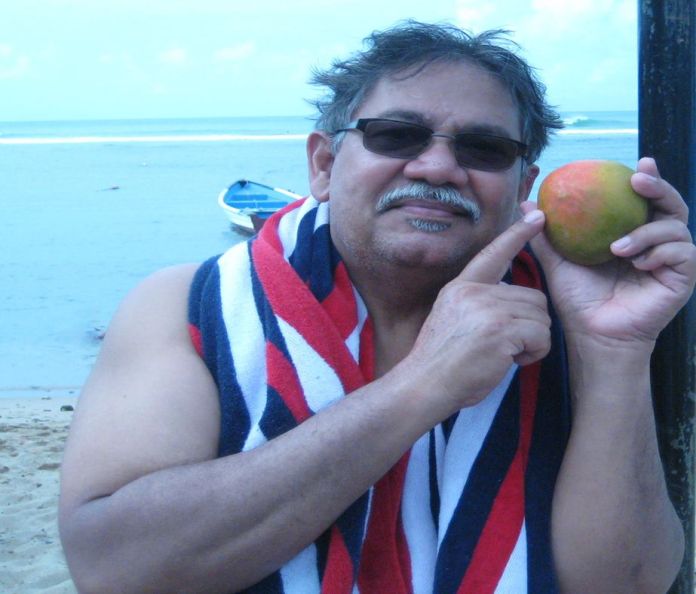By Johnny Coomansingh
In a vast desert of pure green mangoes, I wish to explain my encounter with a single ripe mango, a mango I labelled the “Miracle Mango.” Have you ever heard of that variety of mango? Let us see how this mango got its name. Travelling along with a friend on Toco Road to get to the beach, I saw thousands of green mangoes happily swaying in the breeze on heavily laden trees. I thought to myself, I would be extremely delighted if I could get just one ripe mango up here in Toco. As I mused about having such a delight, I remembered a serious challenge I had as a child.
“Yuh want ah mango? Dance the Shango!” Spoken to me as a child, these words rang in my ears throughout my life. I never understood why I was told to dance the Shango. What was the Shango Dance anyway? Well, as far as my research informs, Shango is a religion observed in Trinidad and Tobago. The term Shango is used loosely to refer to the Orisha religion practiced on the islands. However, my research also shows that Shango is the God of Thunder, one of the Orishas worshipped by the Yoruba people of Africa. I guess, there are drums and dances in the worship of Shango. As a child, telling me to dance the Shango was very confusing, but my older siblings had me in their grip to make fun of me for a mango.
Known as am in India, the word mango means people. Mango originally came to Trinidad from India. Indentured servants of the British crown brought mango cultivars to Trinidad. In his article taken from the Trinidad Guardian Newspaper, A Passage of Indian Ancestral History in Trinidad and Tobago, Paras Ramoutar pointed out that among other items, the Indians brought mango trees with them. Mango was a part of their cultural baggage. We are extremely fortunate to have such a wonderful and luscious fruit in Trinidad today. In Trinidad, it is said that when mango is in season people would turn down their pots. No cooking!
Mango literally took root in all parts of Trinidad and many people relish the vast varieties of mango growing on the island today. In Antigua there in an event known as the “Mango Festival” but in Trinidad, we have a festival of mangoes. There are several cultivars of mango in Trinidad today. We tend to savour the more delectable varieties such as Julie, Starch, Graham, and Buxton Spice. These varieties fetch quite some money for the sidewalk vendors in Sangre Grande and elsewhere. Depending on size, freshness, firmness and colour, mango would sell three or four for ten or even 20 Trinidad dollars. Many people will spend their last dollar to acquire a Julie or a Starch mango.
Some swear that the Starch variety is the best tasting while others argue in favor of the Julie. The other “less” appreciated mango varieties, to name a few, include Long (Vert), Peter, Doux-doux (very sweet), Sugar, Cutlass, Round, Zabrico, Mangotine, La Brea Gyul, Belly-bef, Princes Town Doux-doux, Ten Pound, Bastapool, Calabash, John, Table, Spice, Ice Cream, Turpentine, Donkey, String, Paw-poi, Rose, and Hog mango.
Long mango has two varieties; a rosy one and the other a greenish-yellow. Although there are mango lovers who swear by the taste of a ripe, stale, long mango for its sweetness, this cultivar is not one of my favorites. If I can’t get a Starch or a Julie, I would much prefer a Buxton spice or well-ripened, solid ripe Calabash mango; one that I could slice. I love Sugar and Round mango, and would not mind a couple of fresh Doux-Doux and some good solid Rose mango. I could “suck” a whole bucket of Round or Doux-Doux mango in one fell swoop. Round mango is plentiful in Cumana, Toco. Doux-doux mango is plentiful in the village of Fishing Pond, at least when I used to visit there in my youthful years.
Half-ripe Long and Rose mango could make a really mouth-watering “Mango Chow.” In fact, any mango could make chow. To make a chow, the mango must be washed, peeled, and cut into small bits. Add to the bowl, slices of hot Scotch Bonnet pepper pods, chadon beni also known as bandhania or culantro (Eryngium foetidum), salt, a couple cloves of crushed garlic, a dash of lime juice, and black pepper. Despite the peppery ingredient, most people love Mango Chow.
As with everything else, mango eaters have their likes and dislikes. Some people love John mango others may prefer Cutlass mango. Taste and mango culture is all. So much for all this lengthy mango talk. Nevertheless, as mentioned before, there is one mango known as the Miracle Mango…my very special variety of mango. There was only one such mango in the whole wide world. One!
There was no one around to tell me to “dance the Shango for ah mango,” I was determined to somehow get a delicious ripe mango. Travelling to Toco for a sea bath, I saw mango trees laden with fruit on each side of the road. My eyes were peeled looking for just a glint of yellow or red on the trees. To my disappointment, all the mangoes I saw were unripe!
There wasn’t a ripe mango in sight. Using a little Trini dialect, I quietly started to talk to God. “God, ah know is you dat make mango…” but in that moment of my anxiety and frustration I shouted out: “Yuh mean dat ah man cyar geh one ripe mango up hyah?” My friend just laughed. I did not quite finish the thought when I heard “bup!” As we slowly turned a certain corner, this rosy ripe mango fell “bup” and rolled right in front of us on the roadside. I didn’t know where the “bup” was coming from but became alerted that something had fallen from somewhere with enough “bup” to attract my attention.
As though crazy, I said, “Stop! Stop! Look ah mango just fall dey boi!” It was as though God just pelted us with a mango. And there it was! It was a mango that apparently came out of nowhere; it was a nice ripe Julie mango. The mango rolled and found itself in the road right in front of the car; “The Miracle Mango.” I alighted from the vehicle and promptly scooped up the mango. For the next few moments it seemed as though time stood still. I was too stunned to even talk.
Ahhh…Is there anything to beat the pleasure of the taste of a fresh, firm, ripe, rosy Julie mango? For such a miracle we gave thanks and shared the mango as “communion.”




